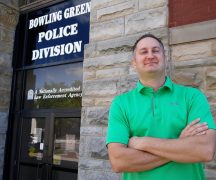By JAN LARSON McLAUGHLIN
BG Independent News
Teachers pleaded to be armed with adequate resources – not guns. Parents asked about mental health care for children. And others debated the value of arming a school for violence, or preventing it before it occurs.
Though the last school shooting was far away in Parkland, Florida, the ripple effect is being felt at schools across the nation.
Bowling Green Superintendent Francis Scruci has held eight expulsion hearings in the past week for students who have made threats of violence at school. Some threats were posted on social media, some blurted out in the school hallways, one uttered in anger while playing an Xbox game.
“We have to take these seriously,” Scruci said. “I’ve got 3,100 kids I’m responsible for, and close to 400 staff I’m responsible for.”
The school safety public forum Thursday evening was held as an open conversation with the community in the atrium of the Wood County District Public Library.
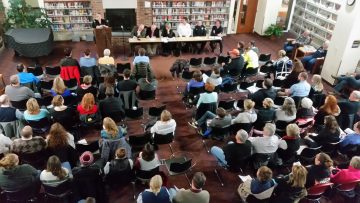
School safety forum at library
The room was packed. The topic was touchy. But the forum was peaceful.
“This type of event could happen anywhere,” Scruci said, talking about how schools and churches used to be safe places in the community.
To make sure Bowling Green schools are as safe as possible, Scruci said he has been working closely with Police Chief Tony Hetrick and Fire Chief Bill Moorman, both who attended the forum.
The district has taken steps such as limiting the times the schools are unlocked, reducing the number of open entrances at the beginning and end of the school day, changing the procedures for evacuating for a non-scheduled fire alarm, reviewing of lockdown plans with staff, talking with evening users of the schools buildings about not blocking open doors, promoting the anonymous tip line, and adopting a zero tolerance policy to threats.
Scruci said he has walked the school buildings with emergency responders and State Senator Randy Gardner.
“It’s not possible to make schools 100 percent safe,” Scruci said. “They were built at times we didn’t have to worry about these events.”
“We all share the same concerns – how to make our schools a safe place,” he said.
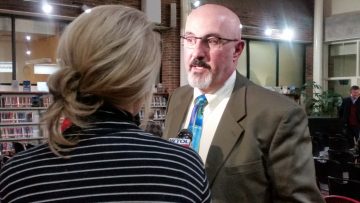
Francis Scruci
Hetrick said he has been having daily conversations with Scruci recently about school safety issues. The police have increased their presence at the schools with foot patrols and drive-throughs of the parking lots. “We have stepped that up,” he said.
Though the police division does not have enough officers to station one at each school, Hetrick said DARE Officer Robin Short is committed to the schools. “She’s really our eyes and ears for problems,” he said.
To help ease the minds of parents, the police chief said city officers have an average response time of one or two minutes. They are well equipped, train for active shooter responses, and are familiar with all the school buildings.
Unlike police responses back at the time of the Columbine school shooting, Bowling Green police officers are trained for “solo engagement,” which means the first officer on the scene goes in immediately by himself.
“This is on our minds all the time,” Hetrick said. “This is what we train for. This is what we’re equipped for.”
The police are also trained in the rescue task force concept, which means fire department personnel enter the building with the police.
Fire Chief Bill Moorman said three paramedics are trained to go into active shooter scenes with police, so there is no delay in medical treatment. He also assured parents that the city’s firefighters are well trained, plan for responses in schools, and have quick response times.
When the forum was opened up for public comments, just seven people spoke.
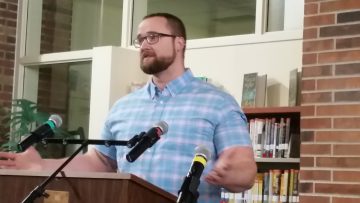
Thomas Mowen
Thomas Mowen, a criminologist at Bowling Green State University, said he has spent much time researching school safety and security.
“Schools have never been safer. Schools continue to be a safe haven for students,” Mowen said. “School shootings are tragic events. But they are very rare.”
Research has shown that putting more police in schools does not always have the intended results. More students tend to be arrested for minor offenses, he said.
“Putting more police in schools doesn’t make schools safer,” Mowen said. “The answer isn’t increasing security.”
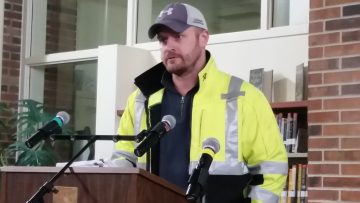
Grant Chamberlain
Grant Chamberlain talked about equipping the schools to respond before police officers arrive on the scene. He suggested teachers should be trained in triage, so they can tend to gunshot victims in the vital minutes before first responders arrive. Chamberlain also proposed teachers should be trained to carry concealed weapons.
“We want to return the children to their families alive,” he said.
But two teachers said arming them with guns in the classroom is not the answer. The focus needs to be on prevention, they said.
“If you want to arm us with something, arm us with the resources we need,” said second grade teacher Stacey Higgins.
Teachers are unable to address all the needs of their students, Higgins said.
“We really don’t want you to arm us, unless you’re going to arm us with things we need to do our jobs,” kindergarten teacher Kisha Nichols said.
Students needs more counselors and mental health specialists, Nichols said.
And if the community wants to help, they should volunteer with programs like the Breakfast Buddies program – which helps children make needed connections with community members. The program suffers from a lack of volunteers, Nichols said.
Kirsty Sayer asked if steps could be taken to make students feel safer at school. She suggested that students be given strategies to use in case of school violence, or be taught conflict resolution skills.
“So they feel a little more empowered,” Sayer said.
Jorge Chavez suggested that the best strategy is not waiting for the crisis to happen.
“We need to address this and be proactive,” he said. That will take the community, parents and teachers working together to build inclusion, “before it reaches that crisis point.”
“We need to find more ways to make kids feel more bonded to their schools and to friends,” Chavez said.
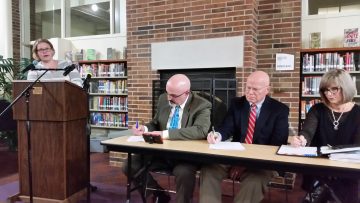
Tracy Hovest speaks
Tracy Hovest suggested that more responses should be directed toward mental health treatment.
“It’s not just about the schools and making them fortresses,” Hovest said.
Scruci expressed his thanks for the parents and students who have reported the recent threats.
“We’ve had a rough week here since last Friday,” he said.
Students who threatened violence at school face 10 days of suspension, then have a hearing to determine if it is safe for that student to go back to school. Some threats are more serious, and some students can be ordered to go to treatment.
“We’ve been very consistent and have taken a no-nonsense approach,” Scruci said.
Though the focus on school safety is necessary, Scruci expressed frustration at the amount of energy schools are having to exert to make their buildings safe.
“I’m disappointed. We’re supposed to be talking about academics,” he said.





